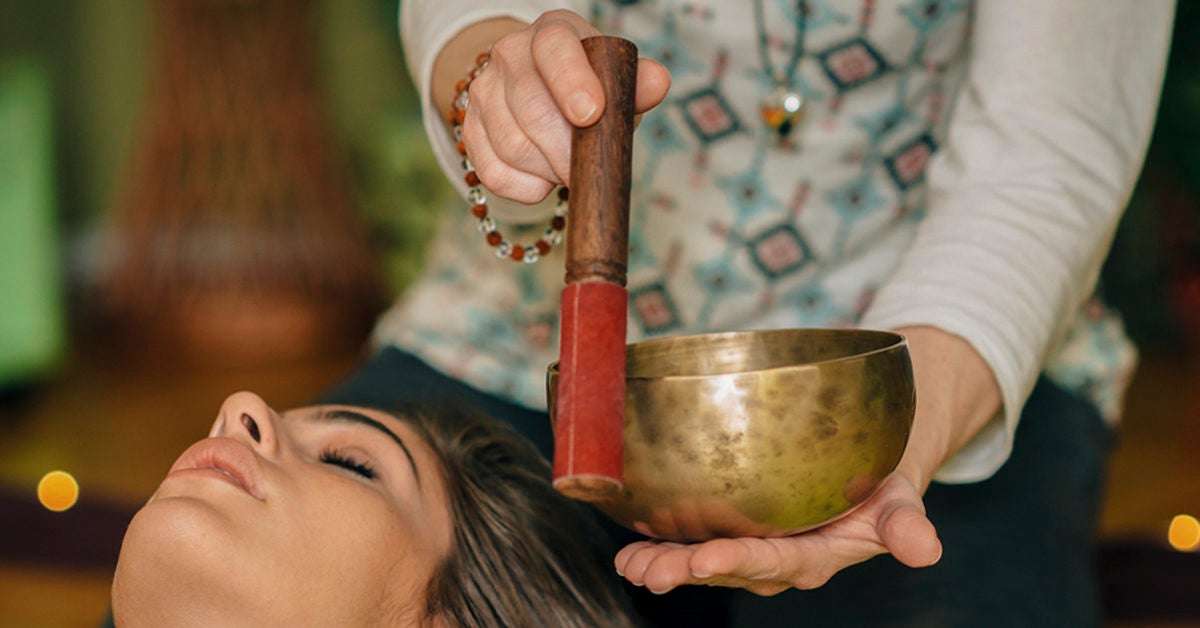You’ve no doubt felt it: Whether it’s Bach or Beyoncé, music can elicit a variety of reactions in your body and mind. Now, some therapists are using that concept to help patients combat common ailments. Sound therapy is having quite a moment these days, spurred by a growing interest in wellness and claims like improved focus and decreased physical pain.
The evidence is everywhere. In New York City, studios like Maha Rose and Woom Center boast audio healing sessions. In Los Angeles, The Soundbath Center and LA Sound Healing generate at least enough interest to keep the competing locations in business. At wellness destinations like the Four Seasons Resort Orlando and Miraval in Tucson, sound therapy is a growing trend. And on YouTube, multi-hour videos tagged “sound therapy” have garnered millions upon millions of views.
So why is this practice catching on now? Like other ancient techniques and wellness boosters newly endorsed by popular science (kombucha, psychedelics, Ayurveda) most of us still have quite a few lingering questions about the trend. We spoke with the experts to find out what sound therapy offers its participants, how it works, and why you might want to take the plunge and try it for yourself.
More From Prevention

So, what is sound therapy?
Sound therapy covers a range of treatments, from music therapy to sound baths, according to Nada Milosavljevic, M.D., founder of the Integrative Health Program at Massachusetts General Hospital. Like massage therapy, which delivers healing through touch, it’s a form of sensory therapy, and it has been used by various cultural groups for centuries. The most prominent form practiced in the U.S. is music therapy, but the use of individual sounds and frequencies has been growing. Essentially, sound and music are noninvasive, simple, and cost-effective therapeutic tools.
Various flavors of sound healing differ much like other forms of therapy. Sound baths are one of the most common; according to Sara Auster, sound therapist and author of Sound Bath: Meditate, Heal and Connect Through Listening, sound baths use instruments like bowls to initiate “a deeply immersive, full-body listening experience.” There’s music therapy, which uses therapist-guided sounds to enhance memory and alleviate stress. Binaural beats, yet another form, involves playing two separate tones in each ear, which are perceived as a single, almost euphoric tone by the brain. Other forms of sound therapy work much in the same way—sound eases, energizes, and empowers us.
What does a typical session look like?
Depending on the practitioner and the goal, sessions vary widely. Many begin with simple breathing exercises, which help slow the mind and shift focus to hearing. For sessions like sound baths and vibrational therapy, participants sit or lie down in a comfortable position, sometimes with an eye mask or blanket. Often, bowls are placed on the body and around the head.
Other experiences are more active, and may include yoga or tai chi. In one-on-one sessions, sound therapists are more likely to adjust their treatment through feedback, both verbal and nonverbal, focusing the sound on areas of the body that need more help relaxing. Each session can last anywhere from 20 minutes to two hours, or even longer, Auster says.
What kinds of sounds are used?
“Sound baths and sound therapy are not about one particular sound or set of sounds, but about cultivating intention and receptiveness in the listener,” Auster says. Common sound therapy instruments include Tibetan sound bowls, crystal bowls, gongs, tuning forks, chimes, and voice. Sounds can also be pre-recorded, like white noise, ambient music, or guided instructions. The right instrument, tone, and frequency varies with the purpose of the session.
“If relaxation is the goal, the most beneficial sounds include ones with depth and slow melodies, as well as songs with lower frequencies and slow transitions,” Milosavljevic says. Nature sounds such as rain offer consistent white noise, which calms the nervous system and can help alleviate physical pain. On the other hand, steady, upbeat, positive-sounding music can be used to increase energy and enhance focus.
Sound Bath: Meditate, Heal and Connect through Listening

Sound Bath: Meditate, Heal and Connect through Listening
$54 at Amazon
How does sound therapy feel?
The goal of sound therapy “is ultimately balance and restoration, though we have seen emotional release of all kinds, such as crying, euphoria, laughter, and even anger,” says Derek Hofmann, senior director of spa at the Four Seasons Resort Orlando. “This treatment brings emotions to the surface, so oftentimes feelings that you are harboring will arise shortly after a session—or it could take up to a day for you to feel this emotional impact.”
How does it work?
There is no definitive answer to why sound therapy can be so soothing (or sad, or euphoric, or angering). But its practitioners have theories. “The vibrations work by ‘massaging’ every cell in the body,” says Hofmann, who notes that it’s about more than just the meditative, relaxing effects of sound. “In contrast to a traditional massage, which manipulates the surface tissue of the body, this treatment works all the way through your skin, muscle, tissue, and organs.”
Auster sees the experience as a personal journey. “Much of the healing you experience in a sound bath is of your own making,” Auster says. “You are the catalyst for your own change, and it’s you who creates the magic of the experience.”
“We have seen emotional release of all kinds, such as crying, euphoria, laughter, and even anger.”
What benefits does sound therapy have?
Plenty of compelling research supports sound therapy for relief of both physical and psychological pain, Milosavljevic notes. One study by researchers from the University of California found that meditation aided by Tibetan bowls noticeably decreased stress and anger—especially among people who were new to this kind of practice. Another, focusing on patients with fibromyalgia, noted that low-frequency sound stimulation significantly increased the amount of time participants could both sit and stand without pain.
Meta-analyses also support the benefits of sound on health. Researchers at the University of Bonn in Germany found evidence among 30 separate studies to support the use of binaural beats as a way to reduce anxiety. And, analyzing 400 studies, scientists from McGill University linked playing and listening to music with improved overall mental and physical health. Admittedly, individual studies often have small sample sizes. But nearly all of them demonstrate real results. “While sound therapy isn’t a cure-all for most people with severe pain or stress, it’s definitely beneficial,” Milosavljevic says.
How can I try sound therapy?
Sound therapy is only growing in popularity, making it much easier to find than even just a few years ago. The simplest form of access is through the internet, where videos can approximate the sound of Tibetan bowls or binaural beats. Auster and other practitioners also release recordings as records and on sites like Soundcloud.
If you’re looking for a more immersive or one-on-one experience, there are plenty of places to look. The American Music Therapy Association, a national organization, is a great resource for finding certified music and sound therapists wherever you are. Cities both big and small often offer at least one sound therapy center, where it’s possible to experiment with bowls, tuning forks, and other instruments. Yoga studios are also getting in on the trend, so check for sound healing sessions or ask local instructors for referrals.
There is no way to tell which kind of sound therapy is right for you until you’ve tried a few kinds. The experience will be “very personal to you, your emotional state on that day, and your lifetime of experiences and memories,” Auster says. “All you have to do during a sound bath is show up and listen.”
A version of this story originally appeared in the February 2020 issue of Prevention.
Like what you just read? You’ll love our magazine! Go here to subscribe. Don’t miss a thing by downloading Apple News here and following Prevention. Oh,and we’re on Instagram too.

Jake Smith
Jake Smith, an editorial fellow at Prevention, recently graduated from Syracuse University with a degree in magazine journalism and just started going to the gym. Let’s be honest—he’s probably scrolling through Twitter right now.
Sound provides comprehensive recovery-oriented outpatient counseling and case management for King County residents experiencing current mental health symptoms, including specialized programs for adults, children and families, older adults, individuals who are deaf or hard of hearing, BIPOC (Black, Indigenous, People of Color), the developmentally disabled, and criminal or juvenile justice involved adults and youth.
For more information, call Sound Admissions at (206)302-2300.
What Services Are Provided?
- Assessments
- Individual, couple, family and group sessions
- Integrated treatment for co-occurring substance abuse and mental health disorders
- Trauma related services
- Solution oriented care (brief and ongoing)
- Motivational enhancement and life skills
- Emerald House Clubhouse
- Care coordination with child and adult serving systems and agencies
- Employment support (pre-employment, workplace concerns, career transitions)
- Health and wellness, gender specific and stress management groups
What Clients Can Expect?
- A comprehensive assessment that addresses the whole person’s needs and goals across all life domains
- To be partners in the treatment planning process
- Individualized services tailored to their plans
- Services designed to support hope, recovery and resilience
Sound is an approved provider for Medicaid/Apple Health, Medicare, and most commercial health plans.




